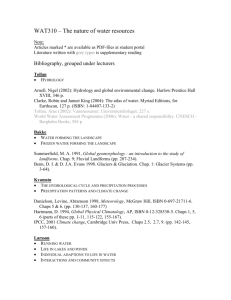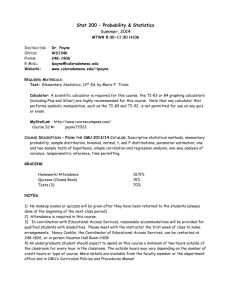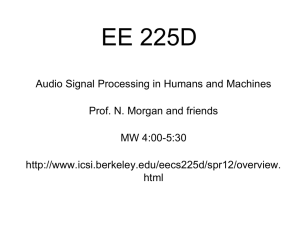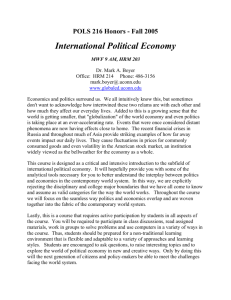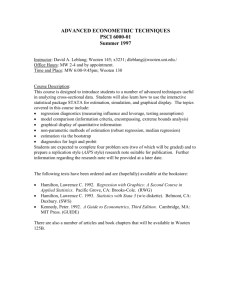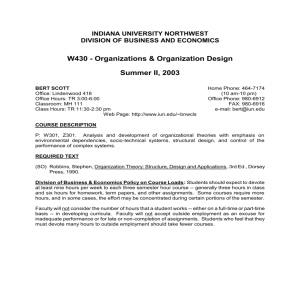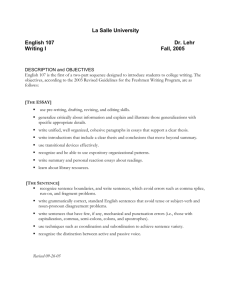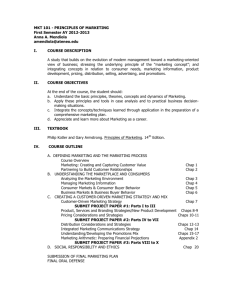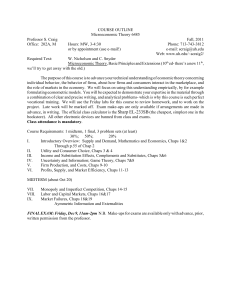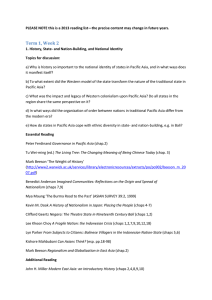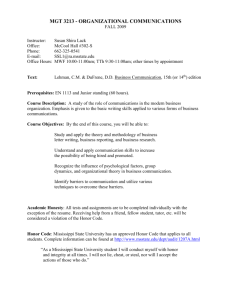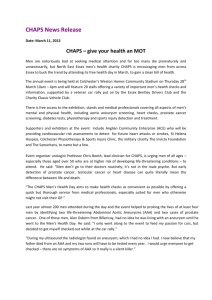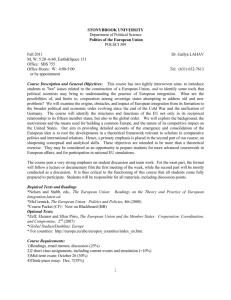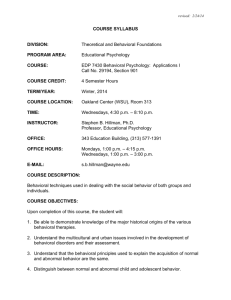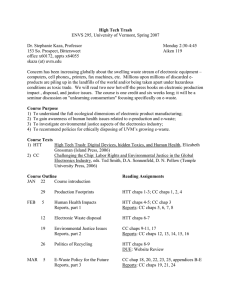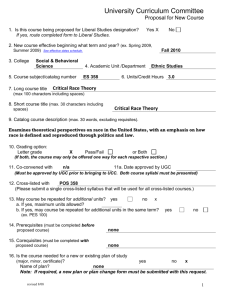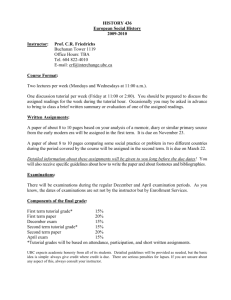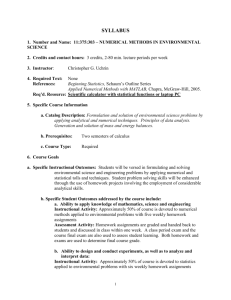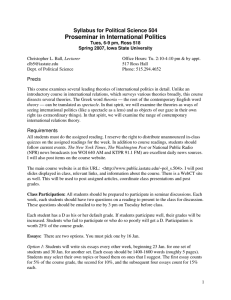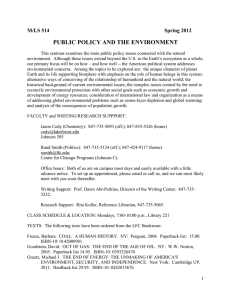Intermediate Statistics
advertisement
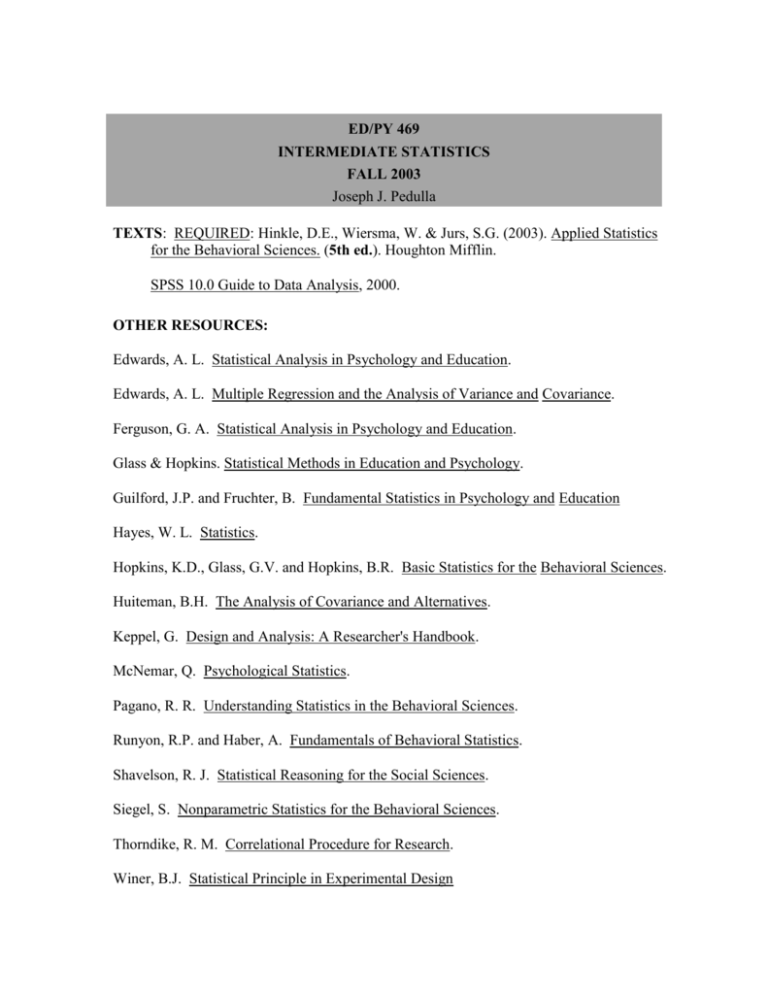
ED/PY 469 INTERMEDIATE STATISTICS FALL 2003 Joseph J. Pedulla TEXTS: REQUIRED: Hinkle, D.E., Wiersma, W. & Jurs, S.G. (2003). Applied Statistics for the Behavioral Sciences. (5th ed.). Houghton Mifflin. SPSS 10.0 Guide to Data Analysis, 2000. OTHER RESOURCES: Edwards, A. L. Statistical Analysis in Psychology and Education. Edwards, A. L. Multiple Regression and the Analysis of Variance and Covariance. Ferguson, G. A. Statistical Analysis in Psychology and Education. Glass & Hopkins. Statistical Methods in Education and Psychology. Guilford, J.P. and Fruchter, B. Fundamental Statistics in Psychology and Education Hayes, W. L. Statistics. Hopkins, K.D., Glass, G.V. and Hopkins, B.R. Basic Statistics for the Behavioral Sciences. Huiteman, B.H. The Analysis of Covariance and Alternatives. Keppel, G. Design and Analysis: A Researcher's Handbook. McNemar, Q. Psychological Statistics. Pagano, R. R. Understanding Statistics in the Behavioral Sciences. Runyon, R.P. and Haber, A. Fundamentals of Behavioral Statistics. Shavelson, R. J. Statistical Reasoning for the Social Sciences. Siegel, S. Nonparametric Statistics for the Behavioral Sciences. Thorndike, R. M. Correlational Procedure for Research. Winer, B.J. Statistical Principle in Experimental Design OFFICE HOURS: Tuesday 2:30-4:15 PM; Wednesday 2:30-4:15 PM; and by appointment. OFFICE: Campion 336B; phone: 617-552-0683 (BC extension 20683) E-mail: pedulla@bc.edu COURSE REQUIREMENTS: Reading assignments for each class All analysis assignments (75% of final grade) An in-class final exam (25% of final grade) COURSE DESCRIPTION This course is a continuation of material presented in ED/PY 468 - Statistics I. As such I assume that you are competent in the area of descriptive statistics. I also assume that you know how to run the SPSS statistical package on a Macintosh or IBM (PC) computer. The basic purpose of this course is to make sure that you have the skills necessary to understand, conduct, and interpret various forms of inferential statistical analysis, e.g. t-test and analysis of variance. Primary emphasis will be placed on conceptual understanding of the statistical techniques rather than on the mechanics of calculating the statistics. SPSS will be a tool to aid in this conceptual understanding, not an end in itself; the statistical computing exercises will attempt to enhance the conceptual understanding, also. Further emphasis is on the correct application of statistical techniques, the interpretation of the results, and the writeup of the problem and results in a style that is practical, complete, and concise. Time will be spent on computer output interpretation. Your skills and understanding will be developed through regular statistical computing exercises. A major component of these exercises is the demonstration, on your part, of individual initiative and resourcefulness in accomplishing the tasks. A teaching assistant will be available to answer questions about course content or assignments. COURSE OUTLINE A. Brief Review of Descriptive Statistics (Chaps. 1-7) (Classes 1 & 2; Sept. 2 & 9) 1. Scales of measurement 2. Central tendency 3. Variance 4. Normal distribution and standard scores 5. Covariance, correlation 6. Regression 7. Principles of statistical inference a. Central limit theorem b. Sampling distributions c. Standard error of the mean d. Sampling designs REVIEW ASSIGNMENT --due Sept. 23 B. Introduction to Hypothesis Testing (Chap. 8) (Classes 2 & 3; Sept. 9 &16) 1. Hypotheses Null and Alternatives 2. Statistical significance Alpha levels One-tailed and two-tailed tests Type I and Type II error C. One sample mean tests (Chaps. 8-9) (Classes 3 & 4; Sept. 16 & 23) 1. z and t-tests 2. Degrees of freedom 3. Point estimates and confidence intervals D. Inferences about the differences between means (Chaps. 11, 13) (Classes 4 & 5; Sept. 23 & 30) 1. Independent groups Homogeneity of variance Confidence Intervals 2. Dependent groups 3. Power (p303-323) Factors influencing power Effect sizes E. Inferences concerning proportions (Chaps.10, 12, 21) (Classes 6 & 7; Oct. 7 & Oct. 14) 1. One-sample case (p223-231) 2. Two-sample case (p280-283) 3. Chi-square distribution a. goodness-of-fit expected frequencies b. test of association c. standardized residuals F. Inferences concerning correlations (Chaps. 10, 12) (Classes 7 & 8; Oct. 14 & 21) 1. Test of a single r (p213-223) Fisher's z transformation 2. Differences between pairs of r’s (p276-279) Confidence intervals G. Inferences concerning regression (Chaps. 17-18) (Classes 9 & 10; Oct. 28 & Nov. 4) 1. Simple linear regression Statistical significance 2. Multiple regression model Significance of model vs. significance of predictors R-squared vs. adjusted r-squared Residual analysis 3. Partial correlation H. One way ANOVA (Chap. 14) (Classes 11 & 12; Nov. 11 & 18) 1. Model Multiple t-test problem (inflated alpha problem) 2. Assumptions 3. F distribution 4. Power and sample size (some of Chap. 13) I. ANOVA multiple comparison procedures (Chap. 15) (Classes 12 & 13; Nov. 18 & 25) 1. Planned comparisons (a priori) Contrasts 2. Post-hoc comparisons (a posteriori) Per comparison (comparisonwise) error Family-wise (experimentwise) error J. Factorial ANOVA designs (Chap. 16) (Classes 14 & 15; Dec. 2 & Dec. 9) 1. 2. 3. 4. Assumptions Models Main effects Interactions 5. Planned comparisons
